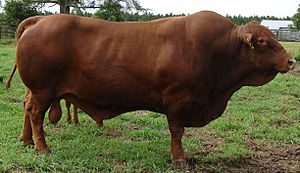Senepol facts for kids
The Senepol is a special type of beef cattle. It was first developed on the sunny Caribbean island of St. Croix. This breed is a mix of different cattle types. It combines traits from European cattle, like the Red Poll, with some Zebu influence.
Senepol cattle are known for being tough. They can handle hot weather and resist insects well. They are also gentle and produce good meat and milk. These cows do not have horns (they are polled). They have short hair and come in red, black, or brown colors.
Contents
How the Senepol Breed Started
In 1860, a man named George Elliot brought 60 young female cows (heifers) and two bulls from Senegal to St. Croix. These were N'Dama Petite cattle. They were good for the island's warm climate. This group became the start of the N'Dama cattle on St. Croix.
By 1889, Henry C. Nelthropp had a large herd of 250 pure N'Dama cattle. His son, Bromley Nelthropp, wanted to make the cows give more milk. He also wanted to get rid of their long horns. So, in 1918, Bromley bought a Red Poll bull from Trinidad. This bull came from England.
Two of this bull's sons were used to breed with the N'Dama cows. In 1942, another Red Poll bull was bought from St. Thomas. Two purebred Red Poll cows from St. Croix were also added to the herd.
The farmers chose the new mixed-breed cattle carefully. They picked cows that were solid red, had no horns, and could handle the heat. These new cows were then shared among four main farms on the island.
The name "Senepol" was chosen in 1954. A special list, called a breed registry, was set up in the late 1960s. This helped keep track of all the pure Senepol cattle.
In 1976, the United States Department of Agriculture helped start testing how well the cattle performed on farms. In 1977, 22 Senepol cows were taken to the United States. Since then, the breed has spread across the southern states.
Today, there are more than 500 breeders with over 14,000 registered Senepol cattle. You can also find them in many other countries. These include Australia, South Africa, Mexico, Brazil, and Puerto Rico.
Senepol Genetics: A Mix of Breeds
Scientists have studied the genes of Senepol cattle. They found that Senepol cows are a mix of European cattle, like the Red Poll, and some Zebu cattle.
A study looked at Senepol DNA from Venezuela. It showed that on average, Senepol cattle have about 89% European genes. They also have about 10.4% Zebu genes. A very small amount, about 0.6%, comes from African cattle like the N'Dama breed.
Strong Against Sickness and Bugs
Research from the USDA shows that Senepol cattle have a strong immune system. This means they can fight off sickness better than some other beef breeds.
This strength likely comes from the Zebu cattle in their family tree. Also, many generations of natural selection on St. Croix helped them become very tough.
In the 1950s, growing sugar cane became less profitable. So, the United States Department of Agriculture helped teach farmers about scientific breeding. This helped improve cattle like the Senepol.
See also
 In Spanish: Senepol para niños
In Spanish: Senepol para niños


